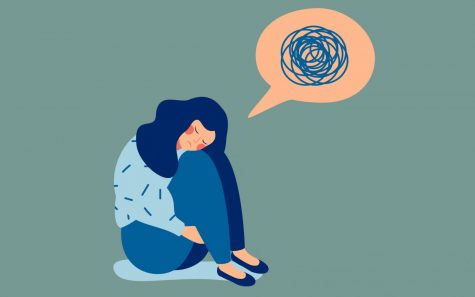Are students in the US more likely to have an anxiety disorder than European students?
I, as an exchange student, have already noticed some differences between Germans and Americans. But one difference, in particular, irritated me: students from the USA bob and shake their legs in class much more than German students. I have never seen that in Germany before. Is it insecurity? Fear? Attention deficit disorder? Too much sugar? I asked a few people from here if this is normal. As answers, I always get something like that it is quite normal and that they have never observed it so actively. But nobody could tell me why it is so common. Since I could not get a concrete answer, I began to research on my own.

To ask somebody, that is everyday around students and an expert in the field of Psychology, I asked Ms. Werner, the Psychology teacher at Imagine Prep, if she knows anything about anxiety disorders: “It makes sense that anxiety disorders and the most common disorder diagnosed; it also makes sense that they are the disorder that humans are least likely to reach out for help for. I think “it’s normal” and “everyone feels this way” are common mentalities people hold when they are struggling with anxiety so they justify not getting help.”
First I called my dad. He is a neurologist and works for the DKFZ, the German Cancer Research Center, and the University of Heidelberg in Germany. He told me that he had never heard of it before. But his first idea was that Americans may eat more sugar than Germans.
After the phone call, I started my research on sugar consumption in the US and Germany. A data from 2015 of the Washington Post says that Americans eat on average 124.6g of sugar per day, while Germans eat on average 102.9g of sugar per day. Maybe that could be the reason. Because I also noticed that American high school students would eat breakfast, before a normal school day, cereals. In my experience that doesn’t fill you. After a few minutes, you are hungry again and just had sugar with milk for breakfast, while Germans normally eat bread or cereals for breakfast.
But I wasn’t completely satisfied by that answer. I wanted to have a better answer to my question. I tried to think of other reasons for that leg shaking.
I started researching mental disorders in Germany and the US and put pressure on students in both countries. From my experience, and also what I found on the internet is that students in the US have way more pressure when it comes to applying for a college and the question, what they want to do in the future. Do I want to go to the Military? Do I want to apply to a very good college? What job will I have in the future? But most Germans don’t have that problem. We don’t have Ivy League colleges, and not many students want to go to the military. So they just study something in a college that they want to go to. Also, it’s not that hard and not that much effort to apply to a college in Germany. Maybe that’s another reason. Maybe American students get more stressed in high school or connect the school with the effort of applying for college and the question about the future.
Ms Werner agreed: “I believe that the United States is an individualistic society which impacts anxiety. There is this (spoken and unspoken) expectation placed on everyone to “make it” or “get it together” or “to be successful” or “to grow up” or “to start a family” or “to do it on your own” or “to be attractive” or (etc. etc. etc.); essentially, “to be the best” or “to fit the mold” and if you’re not or you don’t, well, then you “aren’t enough”. This can place an immense amount of pressure on individuals and significantly influences why they do what they do. This could influence one person to go all-in with school, and it could influence another person to pick at their fingers; this could influence one person to be incredibly confident. and it could influence another person to feel that no matter what they do, it’s never enough.”
Also, I found out that Americans are 29.9 percent more likely to have an anxiety disorder, while Europeans are 13.6 percent likely to have an anxiety disorder. That makes sense when connecting it with my observation. The Center of Disease Control and Prevention says that 7.1 percent of children aged 3-17 years (approximately 4.4 million) have diagnosed anxiety.
In conclusion, there is no direct reason for my observations. But after spending a semester in the U.S., I can definitely say that American high school students seem to be more nervous or anxious.
Also I want to add that if you see someone that maybe needs help please offer your help or talk with other people about it. These people could be your parents, friends or teachers.
Ms Werner had some words for that too: “I think it takes someone else to be like “hey, that’s not ‘normal'” or “hey, I think I know someone who could help with that” in order for someone to go get help.”




